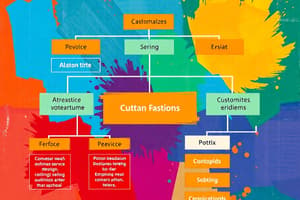Podcast
Questions and Answers
What is the primary purpose of Service Level Agreements (SLAs)?
What is the primary purpose of Service Level Agreements (SLAs)?
- To monitor employee performance in service roles.
- To define service parameters and expectations between providers and customers. (correct)
- To create guidelines for resolving customer issues.
- To track customer satisfaction scores.
Which metric specifically measures the percentage of issues resolved during the first interaction?
Which metric specifically measures the percentage of issues resolved during the first interaction?
- Mean time to recovery
- Customer effort scores
- Response time
- First contact resolution rate (correct)
What challenge may organizations face when implementing Service Level Management (SLM)?
What challenge may organizations face when implementing Service Level Management (SLM)?
- Increased customer satisfaction
- Reduction in operational costs
- Streamlined service delivery
- Difficulty in accurately measuring customer needs (correct)
Which benefit of implementing CDFOM and SLM focuses on reducing customer churn?
Which benefit of implementing CDFOM and SLM focuses on reducing customer churn?
What does 'mean time to recovery' refer to in Service Level Management?
What does 'mean time to recovery' refer to in Service Level Management?
Which of the following metrics assesses how much effort is required by the customer?
Which of the following metrics assesses how much effort is required by the customer?
What is a common misconception about the implementation of SLAs?
What is a common misconception about the implementation of SLAs?
Which factor is essential for improving service delivery according to the integrated application of CDFOM and SLM?
Which factor is essential for improving service delivery according to the integrated application of CDFOM and SLM?
What is the primary objective of Service Level Management (SLM)?
What is the primary objective of Service Level Management (SLM)?
Which of the following is NOT a pillar of Service Level Management?
Which of the following is NOT a pillar of Service Level Management?
How does CDFOM enhance customer experience?
How does CDFOM enhance customer experience?
What is involved in the 'Review and Reporting' aspect of SLM?
What is involved in the 'Review and Reporting' aspect of SLM?
What does the integration of CDFOM and SLM aim to achieve?
What does the integration of CDFOM and SLM aim to achieve?
What is the significance of establishing mutually agreed-upon service levels?
What is the significance of establishing mutually agreed-upon service levels?
What is the role of monitoring service levels in SLM?
What is the role of monitoring service levels in SLM?
What does continuous improvement in SLM involve?
What does continuous improvement in SLM involve?
Flashcards
Response Time
Response Time
The time it takes for a service provider to acknowledge a customer request.
Resolution Time
Resolution Time
The time it takes to completely resolve a customer issue.
First Contact Resolution Rate
First Contact Resolution Rate
The percentage of customer issues resolved successfully during the first interaction.
Customer Satisfaction Scores
Customer Satisfaction Scores
Signup and view all the flashcards
Customer Effort Score
Customer Effort Score
Signup and view all the flashcards
Service Level Agreement (SLA)
Service Level Agreement (SLA)
Signup and view all the flashcards
Mean Time to Recovery (MTTR)
Mean Time to Recovery (MTTR)
Signup and view all the flashcards
CDFOM & SLM Integration
CDFOM & SLM Integration
Signup and view all the flashcards
What is CDFOM?
What is CDFOM?
Signup and view all the flashcards
What is SLM?
What is SLM?
Signup and view all the flashcards
How does CDFOM encourage customer-centricity?
How does CDFOM encourage customer-centricity?
Signup and view all the flashcards
What is 'Defining Service Levels' in SLM?
What is 'Defining Service Levels' in SLM?
Signup and view all the flashcards
What is 'Agreeing Service Levels' in SLM?
What is 'Agreeing Service Levels' in SLM?
Signup and view all the flashcards
What is 'Monitoring Service Levels' in SLM?
What is 'Monitoring Service Levels' in SLM?
Signup and view all the flashcards
What is 'Review and Reporting' in SLM?
What is 'Review and Reporting' in SLM?
Signup and view all the flashcards
What is 'Continuous Improvement' in SLM?
What is 'Continuous Improvement' in SLM?
Signup and view all the flashcards
Study Notes
Introduction to CDFOM and SLM
- CDFOM (Customer-Driven Function & Organisation Model) is a framework for organizing and managing functions within a service or support organization.
- It prioritizes customer experience and needs in function design and organization.
- Service Level Management (SLM) is a systematic process for defining, agreeing, and monitoring service-level agreements (SLAs).
- SLAs detail the service level providers commit to delivering.
- SLM ensures consistent service delivery, meeting customer needs and expectations.
CDFOM & Customer-Centricity
- CDFOM fosters a customer-centric approach to service delivery.
- Incorporating customer requirements into function design enhances user experience.
- Understanding customer expectations and mapping their journey across touchpoints is key.
- The framework aligns service functions with customer needs.
Service Level Management Pillars
- Defining Service Levels: Specifies service performance requirements.
- Agreeing Service Levels: Establishes mutually agreed-upon service levels and metrics between providers and customers.
- Monitoring Service Levels: Continuously tracks service delivery against agreed-upon levels, using metrics and reporting.
- Review and Reporting: Regularly reviews SLAs, reports on performance, identifies improvements, and adapts to changing needs.
- Continuous Improvement: Adjusts service levels based on performance, feedback, and trends, revisiting SLAs for better outcomes.
CDFOM & SLM Integration
- CDFOM and SLM are interconnected and beneficial.
- CDFOM structures functions according to customer needs, informing SLA development.
- SLM measures and manages function performance, demonstrating framework alignment.
- Integrating CDFOM and SLM optimizes service delivery, focusing on customer satisfaction.
Key Metrics in SLM
- Response time (time to acknowledge a request).
- Resolution time (time to resolve an issue).
- First contact resolution rate (percentage of initial interaction resolutions).
- Customer satisfaction scores (e.g., Net Promoter Score, surveys).
- Customer effort scores (customer effort required).
- Mean time to recovery (time to restore service/system).
Service Level Agreements (SLAs)
- SLAs formalize agreements between customers and providers.
- They define service parameters (response times, resolution times, uptime) and penalties for non-performance.
- SLAs establish clear expectations for all parties.
Benefits of Implementing CDFOM & SLM
- Improved customer satisfaction and loyalty through consistent service delivery.
- Enhanced productivity and efficiency from streamlined service processes.
- Reduced operational costs via effective resource allocation.
- Reduced customer churn by proactively addressing needs and exceeding expectations.
- Clear expectations and responsibilities for service delivery.
Challenges in Implementing CDFOM & SLM
- Resistance to change from stakeholders used to existing systems.
- Difficulty accurately measuring customer needs and adapting function structures.
- Balancing customer expectations with organizational constraints.
- Continuous monitoring and improvement efforts needed for SLAs.
- Consistently gathering accurate data for service delivery adjustments.
Conclusion
- Integrating CDFOM and SLM is a strategic approach for improving customer service and operational efficiency.
- Understanding customer needs, aligning organizational functions accordingly, and meticulously tracking performance against SLAs leads to superior customer service.
Studying That Suits You
Use AI to generate personalized quizzes and flashcards to suit your learning preferences.




